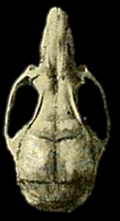Transandinomys bolivaris, also known as the long-whiskered rice rat, is a rodent in the genus Transandinomys. It is found in humid forest from northeastern Honduras to western Ecuador, up to 1800 m (5900 ft) above sea level. Since it was first described in 1901 from Ecuador, six scientific names have been introduced for it, but their common identity was not documented until 1998 and the species had a number of names until it was moved to the new genus Transandinomys in 2006. It is a medium-sized rice rat and has very long vibrissae (whiskers)—those above the eyes are up to 50 mm (2.0 in) long, making it distinguishable from other similarly sized rice rats. The fur, which is soft and dense, is usually dark brown above and light gray below; it is darker in juveniles. The feet are long and the tail is about as long as the head and body. The skull (pictured from above) is narrow and relatively long, and has a broad interorbital region (between the eyes). The species generally lives on the ground, but some young animals have been taken in vegetation, up to 1.5 m (5 ft) above the ground. Although it is rare, its conservation status is thought to be secure. (Full article...)
Part of the Transandinomys featured topic.
Recently featured: Fluorine – System Shock – Gustav Holst
